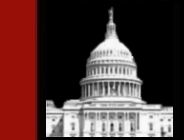Rumsfeld Missile Commission
last updated: November 1, 2007
Please note: The Militarist Monitor neither represents nor endorses any of the individuals or groups profiled on this site.

The Commission to Assess the Ballistic Missile Threat to the United States, commonly called the Rumsfeld Commission or the Rumsfeld Missile Commission after its chair Donald Rumsfeld, operated from January 1998 to July 1998 and issued its final report on July 15, 1998. The commission determined that the ballistic missile threat to the United States was much greater than previously reported, indeed, so great that "the United States might have little or no warning before operational deployment" (Report of the Rumsfeld Commission, Executive Summary, July 15, 1998).
The report concluded that "rogue states" such as Iraq, North Korea, or Iran—the future "axis of evil"—could deploy ballistic missiles within "five years of a decision to do so," thereby contradicting the CIA’s 1995 National Intelligence Estimate (NIE) that it would take at least 10-15 years for rogue nations to develop a missile capacity that could threaten the United States.
As might be expected, right-leaning commentators saw the commission’s conclusions as a green light to begin work on missile defense. A Heritage Foundation analyst summarized the most alarmist aspect of the commission’s report: "A Third World country could develop and deploy a ballistic missile threat against the United States in as little as five years, and U.S. officials would have no way of knowing about it until the threat had materialized" (Baker Spring, July 24, 1998). Accepting whole-hog the notion of a developing nation building and delivering a ballistic missile without U.S. foreknowledge, the Heritage analysis declares: "The warning that the missile threat may be immediate clears the way for Congress to debate more seriously the most effective way to meet this danger."
According to some analysts, the unstated objective of the commission was to turn up pressure on the Clinton administration to support new weapons programs and substantially increase major military spending (see Gronlund and Wright, Bulletin of the Atomic Scientists, November/December 1998). The commission’s report certainly had that effect, as conservative think tanks took the unclassified report and immediately began using it to push for missile defense. The day after the Rumsfeld Commission’s report came out, Gary Schmitt of the neoconservative Project for the New American Century wrote in a memo to "opinion leaders" that "as the findings of the Rumsfeld Commission suggest, when it comes to missile defenses, the [Clinton] administration is pursuing a policy which will inevitably undermine the country’s capacity to exercise that leadership by leaving it, its forces, and its friends unprotected against attacks by ballistic missiles and the deadly warheads they carry" (Schmitt, July 16, 1998).
The missile defense commission was itself the direct result of congressional pressure from right-wing Republicans, orchestrated by such groups as the Center for Security Policy (CSP), the SAFE Foundation (Safeguarding America for Everyone), and American Conservative Union. At the urging of Frank Gaffney, CSP founder and president, Sen. Newt Gingrich (R-GA) included a plank in his 1994 "Contract with America" that called for the rapid deployment of a missile defense system—the only plank in the Republican campaign platform that addressed foreign or military policy at the time.
Rep. Curt Weldon (R-PA) introduced an amendment in the 1997 Defense Authorization bill setting aside funds for a bipartisan commission to study the missile defense threat (see Ciarrocca and Hartung, July 2002). Weldon, who was a proponent of missile defense throughout his terms in office, serves on the advisory board of Gaffney’s neoconservative-led CSP and had close ties to such groups as the American Conservative Union and the National Defense Industrial Association. He was also the chair of the military procurement subcommittee of the House Armed Services Committee.
Strong advocates of missile defense dominated the commission, which besides Rumsfeld included William Graham, Paul Wolfowitz, William Schneider Jr., James Woolsey, as well as three members cut from different cloth than your typical hawks—Richard Garwin, Gen. Lee Butler, and Barry Blechman. Butler was one of two high-ranking retired military officers on the commission. He served as commander-in-chief of the U.S. Strategic Command and Strategic Air Command (1992-1994) and as the director of strategic plans and policy on the Joint Chiefs of Staff (1989-1991). The other officer was retired Air Force Gen. Larry D. Welch, who was the chief of staff of the Air Force (1986-1990) and commander-in-chief of the U.S. Strategic Air Command (1985-1986). He was president and CEO of the Institute for Defense Analyses (1990-2003).
Garwin, a respected scientist, wrote about his experience on the commission, saying adamantly that he would not endorse a missile defense: "The report created a stir. It was enthusiastically received by congressional and think-tank hardliners, who believe the United States must deploy a national ballistic missile defense system soon. Meanwhile, many in the arms control community were dismayed. How could a panel with at least some supposedly reasonable people have handed such potent ammunition to the hardliners? The answer is that analysis of the threat should be clearly differentiated from analysis of the response to that threat.
"Insofar as the Rumsfeld report is concerned, it should—and must—be regarded as neutral regarding missile defenses. The commissioners simply did not consider whether deploying the national ballistic missile system as currently conceived represented wisdom or folly. Presumably, some of the commissioners would favor such a system. Others—and that assuredly includes me—would not" (Garwin, Bulletin of the Atomic Scientists, November/December 1998).
Rumsfeld hired Stephen Cambone, a longtime associate, as the commission’s staff director. Staff members for the missile defense commission included David Dunham and Eric Desautels of TASC, Inc., Dolonnie Henry of the National Defense University, Steven Maaranen of the policy planning staff of the Los Alamos National Laboratory, and Jason Roback and Bernard Victory, on loan from the National Institute for Public Policy (NIPP). On the eve of George W. Bush’s 2001 inauguration, NIPP, a militarist institute strongly supportive of President Ronald Reagan’s "Star Wars" initiative, published "Rationale and Requirements for U.S. Nuclear Forces and Arms Control," a report that served as a blueprint for the new administration’s more aggressive nuclear weapons policy (National Institute for Public Policy, January 2001). Cambone was on the team that produced the NIPP report, as were Kathleen Bailey, Robert Joseph, Linton Brooks, William van Cleave, Stephen Hadley, Fred Ikle, and Max Kampelman. NIPP president, Keith Payne, was the study director.
Several players connected to the Rumsfeld Commission later became part of the George W. Bush administration. Rumsfeld was named defense secretary; Wolfowitz became deputy defense secretary; and Rumsfeld named Schneider to the Defense Science Board. In March 2003, Cambone became undersecretary of defense for intelligence—a new position created by Rumsfeld.
Although the Rumsfeld Commission’s panicky conclusions were initially challenged by the director of central intelligence, a little more than a year later, in September 1999, the CIA released a new National Intelligence Estimate that was substantially more alarmist than its previous NIE. The CIA predicted that North Korea could test a ballistic missile capable of hitting the United States "at any time" and that Iran could test such a weapon "in the next few years." Commenting on the new threat assessment, Weldon congratulated himself: "It was the largest turnaround ever in the history of the [intelligence] agency." As a main sponsor of the Rumsfeld Commission, said Weldon, "I was part of making it happen" (Washington Post, January 14, 2002). Gingrich was similarly ecstatic. Finally the right wing had a new set of external dangers to rally around and to leverage into increased defense spending. Referring to the commission’s report, Gingrich exulted that it was the "most important warning about our national security system since the end of the Cold War" (Nation, January 29, 2001).
Although CIA officials argued that the new NIE was the result of "improved trade-craft," many experts attributed the revision to pressure from hardline Republicans, the considerable influence of Rumsfeld, and a campaign by Israel to focus attention on what the Likud government of Prime Minister Benjamin Netanyahu saw as a rising missile threat from Iran. Joseph Cirincione, director of the nonproliferation program at the Carnegie Endowment for International Peace, argued that the CIA’s 1995 NIE "holds up pretty well in hindsight." He also accused Weldon and other Republican hawks of developing "a conscious political strategy" to attack the CIA’s 1995 NIE because "it stood in the way of a passionate belief in missile defense" (Washington Post, January 14, 2002).
Shortly after the Rumsfeld Commission ended its work, Rumsfeld chaired a second congressional commission, the Commission to Assess United States National Security Space Management and Organization, which was informally known as the Space Commission or the Rumsfeld Space Commission. Cambone again served as Rumsfeld’s staff director.
The two Rumsfeld commissions focused on the issues at the top of the list for the national security militarists and the large military contractors: the ballistic missile threat to the United States and U.S. space-based defense capabilities. In the tradition of Team B in the mid-1970s, the apparent agenda of both these commissions was to pressure the administration into increased military spending and new weapons programs (see Gronlund and Wright, Bulletin of the Atomic Scientists, November/December 1998). Both commissions received funding from defense spending bills—in effect using taxpayer revenues to subsidize them.
